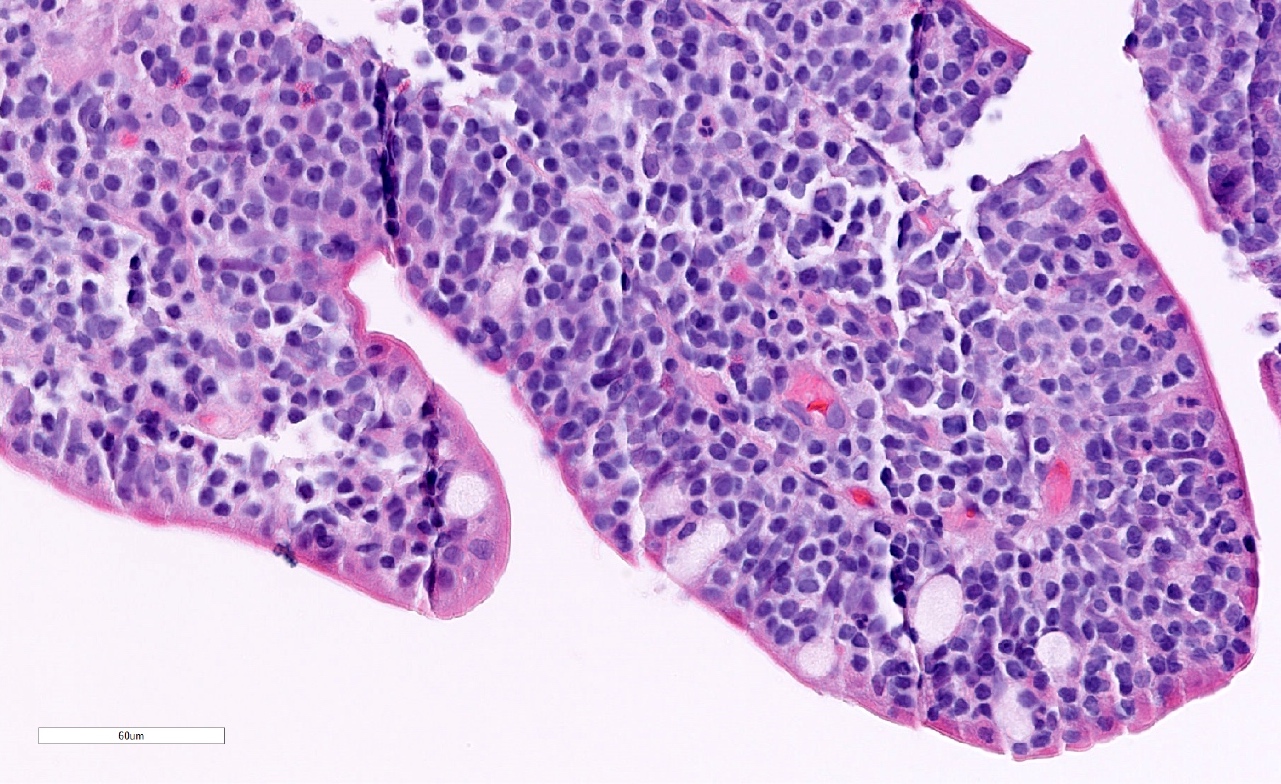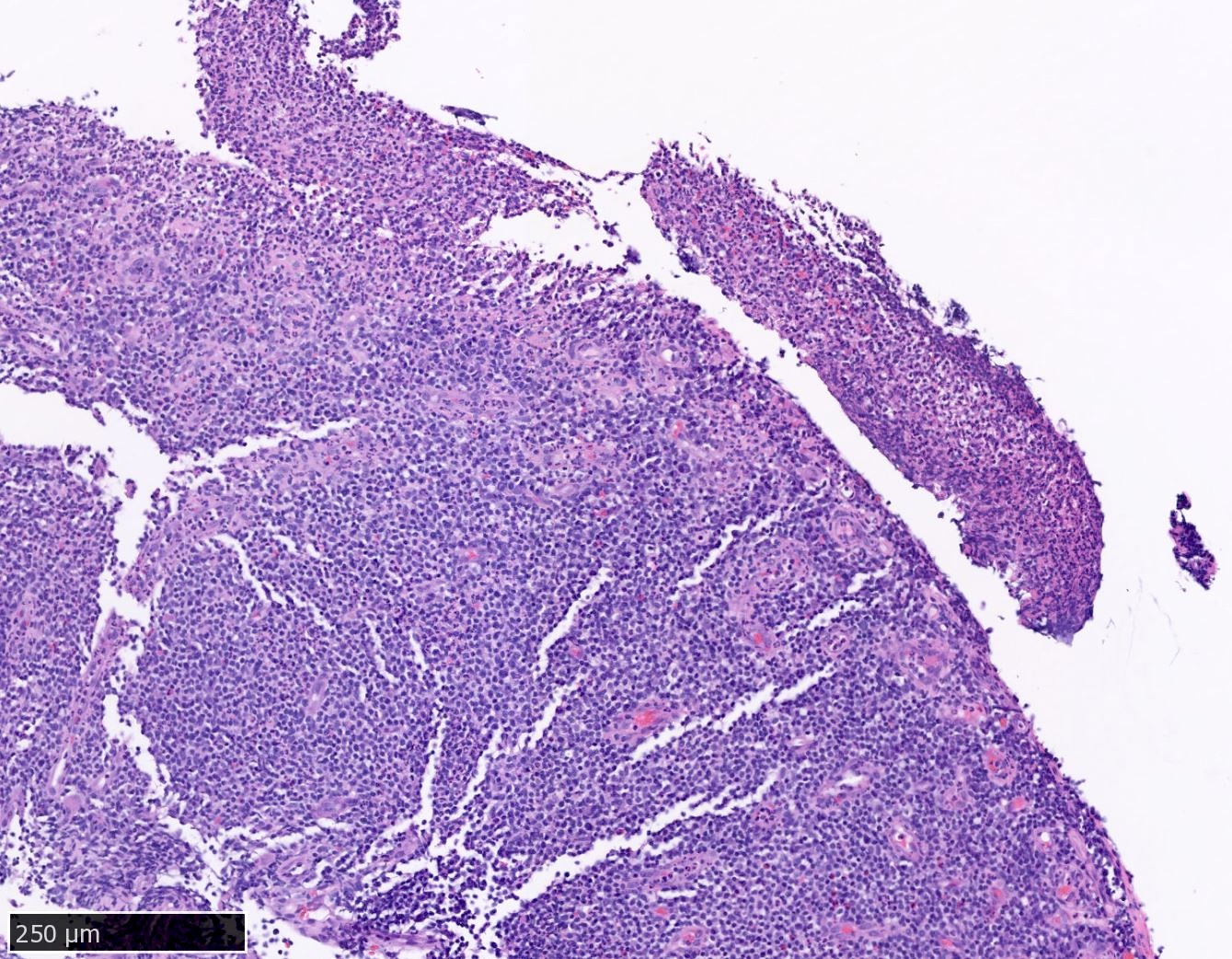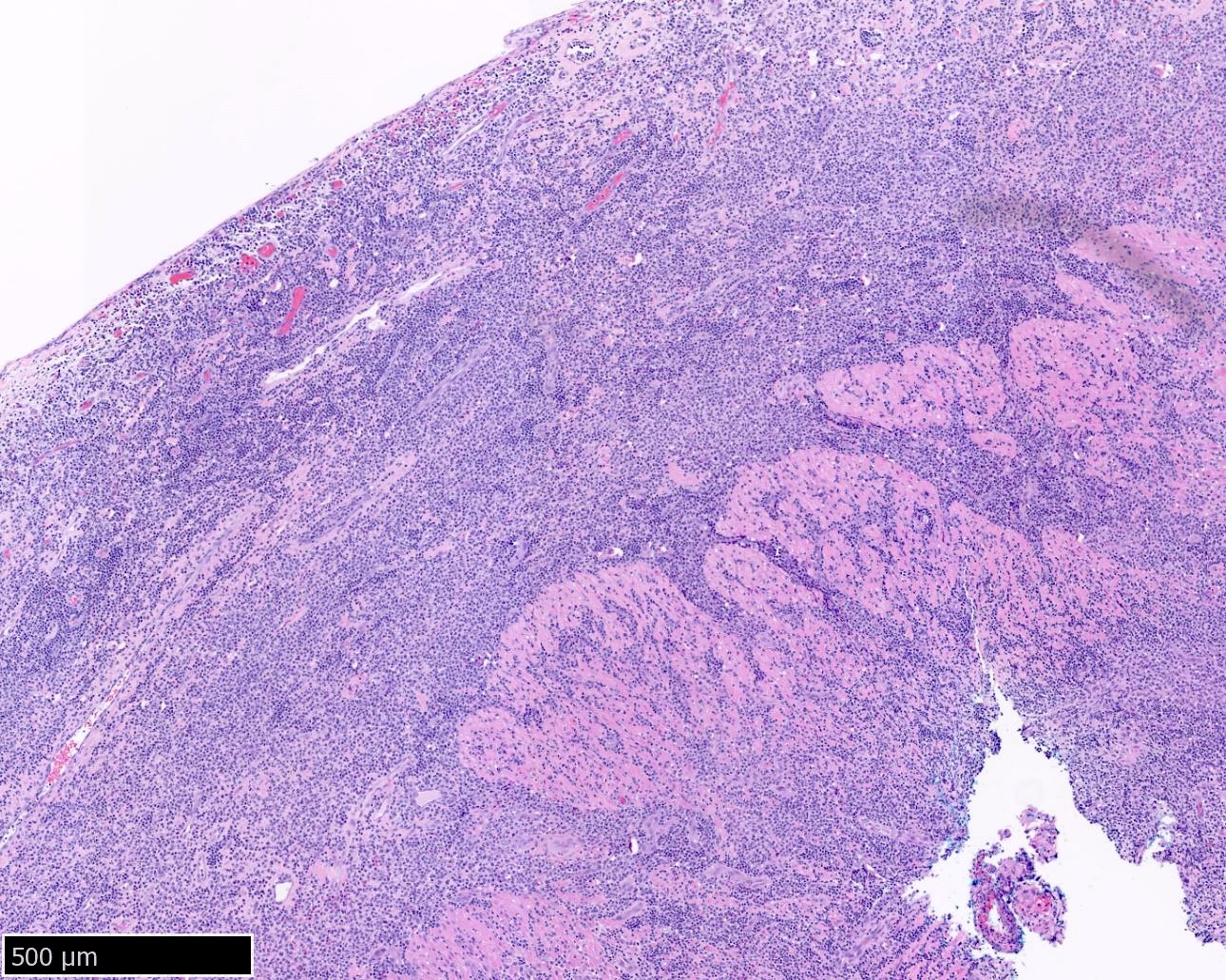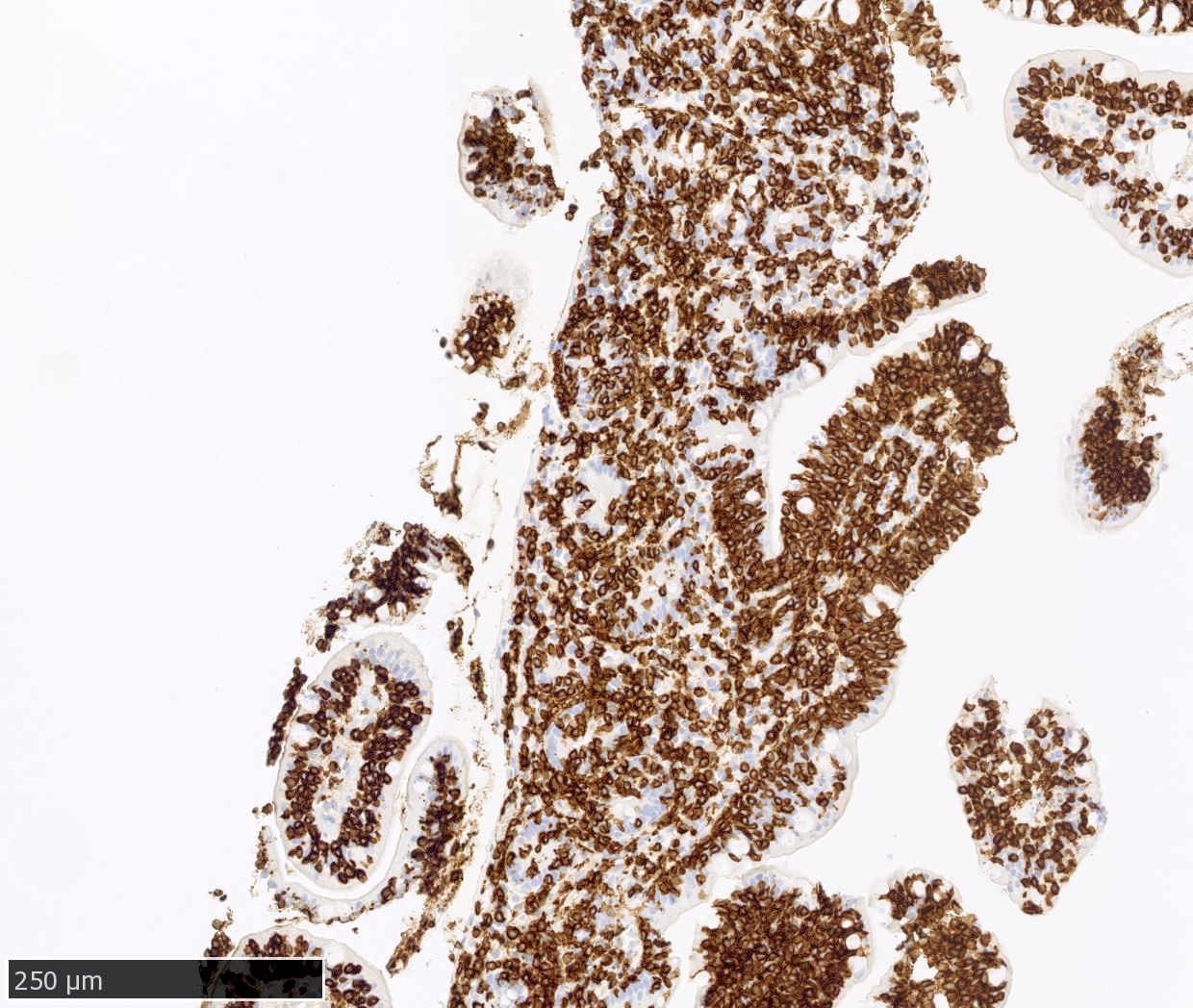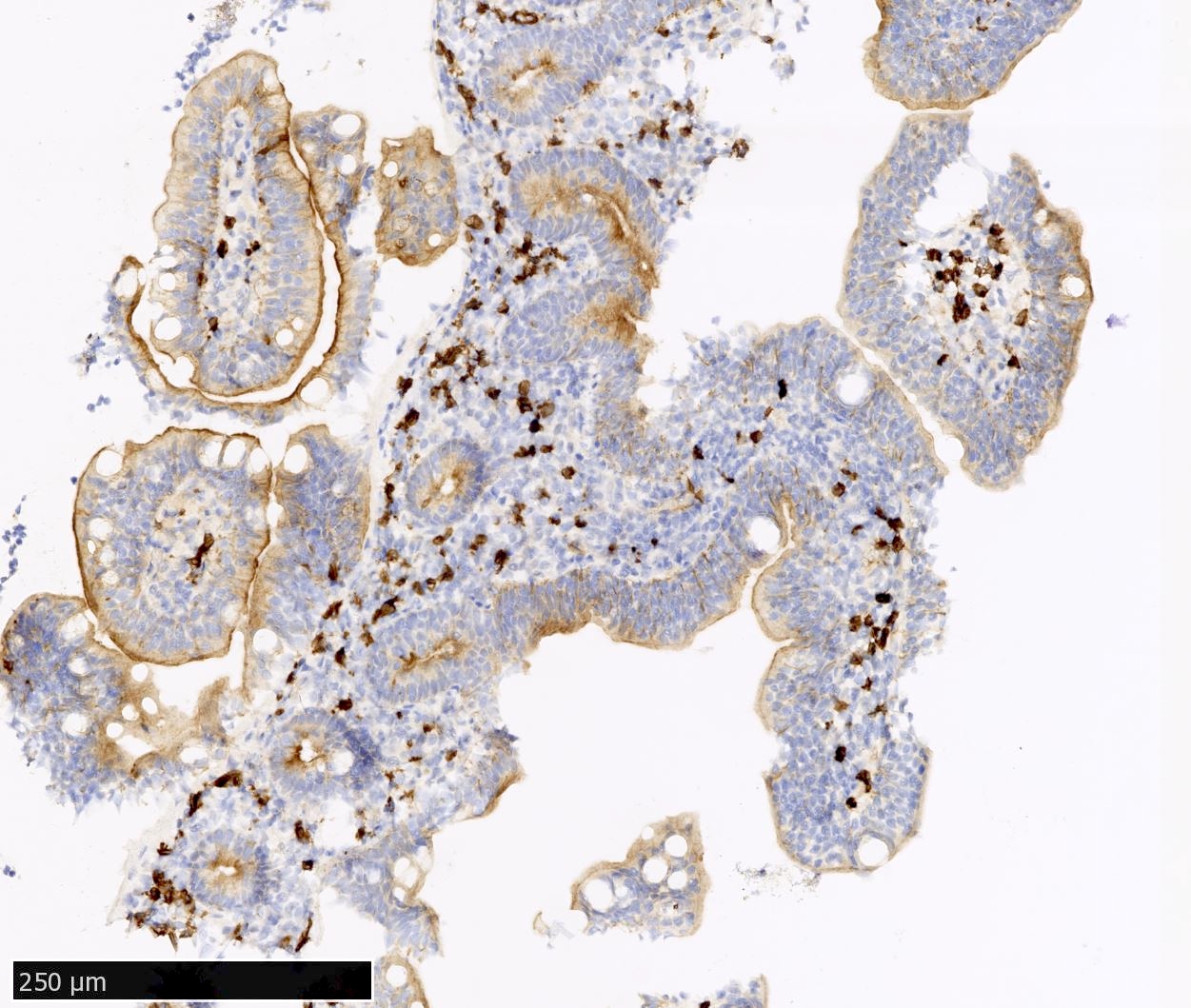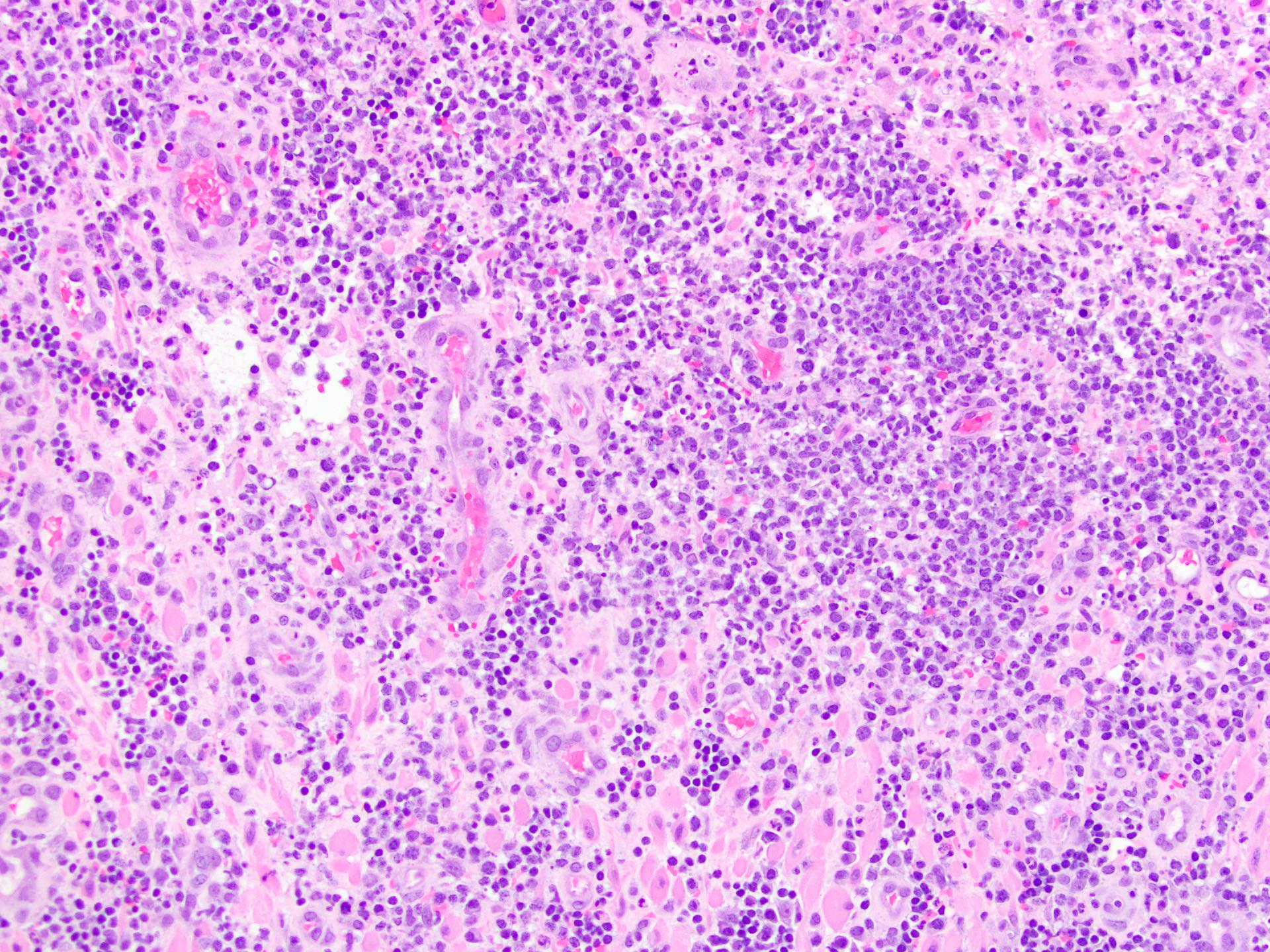Table of Contents
Definition / general | Essential features | Terminology | ICD coding | Epidemiology | Sites | Etiology | Diagrams / tables | Clinical features | Diagnosis | Radiology description | Prognostic factors | Case reports | Treatment | Gross description | Microscopic (histologic) description | Microscopic (histologic) images | Positive stains | Negative stains | Sample pathology report | Differential diagnosis | Additional references | Practice question #1 | Practice answer #1Cite this page: Goksu BB, Murga-Zamalloa CA. Intestinal T cell lymphoma, NOS. PathologyOutlines.com website. https://www.pathologyoutlines.com/topic/lymphomaintestinalt.html. Accessed August 29th, 2025.
Definition / general
- Primary intestinal T cell lymphomas (ITCL) are rare malignancies that account for < 10% of intestinal lymphomas
- Diagnosis of the not otherwise specified category (ITCL, NOS) is established when there is a failure of classification with the current schemes
Essential features
- Intestinal T cell lymphoma, not otherwise specified is a rare and aggressive variant (Ann Diagn Pathol 2018;37:107)
- Clinical symptoms are nonspecific and the clinical presentation can overlap with inflammatory bowel disease (Diagn Pathol 2022;17:53)
- Imaging studies may reveal a thickened intestinal wall (Diagn Pathol 2022;17:53)
- Histologically characterized by extensive infiltration by atypical lymphocytic infiltrates (Diagn Pathol 2022;17:53, Clin Case Rep 2022;10:e05546)
- Exclusion of other defined categories of intestinal T cell lymphoma is required for diagnosis
Terminology
- ITCL, NOS
- ITCL, unclassified
ICD coding
Epidemiology
- Fewer than 10 cases have been reported (Ann Diagn Pathol 2018;37:107, Diagn Pathol 2022;17:53, Clin Case Rep 2022;10:e05546)
Sites
- The few cases reported demonstrate involvement in the small intestine
Etiology
- Cell of origin is similar to the systemic counterpart (peripheral T cell lymphoma, NOS) and includes 2 major groups (GATA3 versus TBX21 types) (Blood 2019;133:1664, Blood 2014;123:3007)
Clinical features
- Lacks an association with celiac disease
Diagnosis
- Computed tomography (CT) scans can be performed to show intestinal wall thickening; however, a biopsy is required for diagnosis
Radiology description
- Intestinal wall thickening in CT scans
Prognostic factors
- Few cases are reported; survival ranges from weeks to < 2 years after diagnosis (Clin Case Rep 2022;10:e05546, Ann Diagn Pathol 2018;37:107)
Case reports
- 55 year old man with thickened small bowel loop (Diagn Pathol 2022;17:53)
- 65 and 67 year old men (in a case series of 27 patients) with involvement in the small bowel (Ann Diagn Pathol 2018;37:107)
- 73 year old woman with retroperitoneal inflammation and duodenal perforation (Clin Case Rep 2022;10:e05546)
Treatment
- Similar to the systemic peripheral T cell lymphoma, NOS counterpart and includes induction with CHOP chemotherapy (cyclophosphamide, doxorubicin hydrochloride [hydroxydaunorubicin], vincristine sulfate [Oncovin] and prednisone)
Gross description
- Involved areas are characterized by thickened rugal folds
Microscopic (histologic) description
- Dense and extensive infiltrates that are composed of atypical lymphocytes that are medium to large in size, with irregular nuclear contours
- Necrosis may be present
- Epitheliotropism can be present
- References: Diagn Pathol 2022;17:53, Clin Case Rep 2022;10:e05546
Microscopic (histologic) images
Positive stains
- CD2, CD3, CD4, CD8, CD7, CD5, TIA1, granzyme B, Ki67 (> 50%)
- CD30 (may be positive in a subset of tumor cells)
- References: Diagn Pathol 2022;17:53, Clin Case Rep 2022;10:e05546
Negative stains
- EBER
- CD56
- Loss of pan T cell markers (CD2, CD3, CD5, CD7) is usually identified
- Loss of both CD4 and CD8 can be observed
- References: Diagn Pathol 2022;17:53, Clin Case Rep 2022;10:e05546
Sample pathology report
- Small intestine, biopsies:
- Atypical lymphocytic infiltrates, consistent with involvement by T cell lymphoma (see comment)
- Comment: The overall morphological and immunohistochemical findings are most consistent with T cell lymphoma unclassified (not otherwise specified, NOS). Correlation with staging and imaging studies is required. In the right clinical context, the findings can be consistent with primary intestinal T cell lymphoma, not otherwise specified (ITCL, NOS).
Differential diagnosis
- NK / T cell enteropathy (Blood 2011;117:1447):
- Indolent T cell lymphoma of the GI tract (Hematol Oncol 2017;35:3, Blood 2013;122:3599):
- Infiltrates are composed of small lymphocytes with no atypical features
- Ki67 proliferation index is < 10%
- No areas of necrosis or gland destruction are identified
- Indolent clinical course
- Inflammatory bowel disease:
- Lymphocytic infiltrates are composed of a mixture of CD20 positive B cells and CD3 positive T cells
- No cytological atypia is present within the lymphocytic infiltrates
- Normal expression of pan T cell markers within the T cell subsets
- T cell receptor rearrangement studies demonstrate polyclonal T cells
- Enteropathy associated T cell lymphoma (EATL) (Leukemia 2013;27:1688, Pathology 2020;52:128):
- Morphology and immunophenotype do not reliably distinguish between ITCL, NOS and EATL
- EATL is associated with celiac disease
- Monomorphic epitheliotropic intestinal T cell lymphoma (MEITL) (Ann Hematol 2019;98:2541):
- Atypical lymphocytes are monomorphic, medium in size with mild cytological atypia
- References: Table 1, Diagn Pathol 2022;17:53
Additional references
Practice question #1
Which of the following is the correct statement regarding intestinal T cell lymphoma, not otherwise specified?
- All patients characteristically feature persistent diarrhea
- Clinical course is indolent
- Diagnosis requires the exclusion of celiac disease
- Loss of the expression of pan T cell markers is rarely observed
- Lymphocytic infiltrates are benign appearing and indistinguishable from inflammatory bowel disease
Practice answer #1
C. Diagnosis requires the exclusion of celiac disease
Comment Here
Reference: Intestinal T cell lymphoma, NOS
Comment Here
Reference: Intestinal T cell lymphoma, NOS






